Chapter 17.15
RESIDENTIAL DISTRICT REGULATIONS
Sections:
17.15.020 Residential districts.
17.15.040 Area, height, setback and miscellaneous provisions.
17.15.050 Planned residential provisions.
17.15.055 R-2 district design standards.
17.15.060 Recreation space requirements.
17.15.010 Purpose.
The purpose of the residential districts is to allow for different types, sizes and price ranges of high quality residential uses in the city. The districts provide for a variety of urban residential densities with appropriate transitions, and for clustered lot uses. (Ord. 1198 § 22 (Exh. D), 2017; Ord. 744 § 2, 1995).
17.15.020 Residential districts.
The following residential districts are hereby established:
A. Single-Family District (R-1). Single-family detached residential district. The R-1 district shall have the following subdistricts on the basis of minimum lot area: R-1-4 (4,000 square feet); R-1-7.5 (7,500 square feet); and R-1-10 (10,000 square feet).
B. Two- and Three-Family District (R-2). Small scale multiple-family district which may be used as a transitional district between the single-family and higher density multiple-family residential districts. Allow duplex, triplex and quadriplex development.
C. Multiple-Family District (R-3). Low-rise multiple-family district which may be used as a transition zone between the other residential districts and higher intensity nonresidential uses. Encourage a variety of housing types and residential environments by allowing three- and fourplex developments, walk up apartments, and townhouses.
D. Residential Constrained District (R-C). Low density single-family detached residential district. This district is characterized by large parcels subject to significant environmental constraints and lack of adjacent sewer service.
E. Planned Residential (PR). Master planned, principally residential development that encourages a range of housing types, sizes and cost and allows for a limited amount of compatible neighborhood residential uses. (Ord. 1198 § 22 (Exh. D), 2017; Ord. 1151 § 2, 2015; Ord. 744 § 2, 1995).
17.15.030 Use regulations.
The use regulations for these districts are found in Chapter 17.55 SMC, Use and Other Regulations. (Ord. 1198 § 22 (Exh. D), 2017; Ord. 744 § 2, 1995).
17.15.040 Area, height, setback and miscellaneous provisions.
A. The following table indicates restrictions and regulations for minimum lot areas, setbacks, and building height for all residential structures permitted in the R-C, R-1, R-2 and R-3 residential districts:
|
|
|
R-C |
R-1-10 |
R-1-7.5 |
R-1-4 |
R-2 |
R-3 |
|---|---|---|---|---|---|---|---|
|
1. |
Minimum lot area – square feet (sf) |
20,0001 |
10,0005 |
7,5005 |
4,0005 |
6,0008 |
6,000 |
|
2. |
Minimum lot area per dwelling – sf2 |
5 acres |
10,000 |
7,500 |
4,000 |
NA |
NA |
|
3. |
Maximum density – dwelling units/acre7 |
NA |
NA |
NA |
NA |
25 |
30 |
|
4. |
Minimum front yard setback for all principal buildings4 |
25 ft. |
25 ft. |
20 ft. |
15 ft. |
10 ft. |
0 ft. |
|
5. |
Minimum front yard setback for porches for principal buildings4 |
15 ft. |
15 ft. |
13 ft. |
8 ft. |
7 ft.4 |
7 ft.4 |
|
6. |
Minimum setback for all principal buildings and uses on a corner lot and building face which does not contain the main entry4 |
25 ft. |
20 ft. |
15 ft. |
12 ft. |
10 ft. |
10 ft. |
|
7. |
Minimum rear yard setback for all permitted principal buildings and uses4 |
20 ft. |
20 ft. |
20 ft. |
20 ft. |
15 ft. |
15 ft. |
|
8. |
Minimum rear yard setback for all accessory buildings and uses4 |
10 ft. |
10 ft. |
3 ft. |
3 ft. |
3 ft. |
3 ft. |
|
9. |
Minimum side yard setback for all permitted principal buildings and uses4 |
10 ft. |
10 ft. |
5 ft. |
5 ft. |
5 ft.6 |
5 ft.6 |
|
10. |
Maximum side yard setback for all accessory uses4 |
5 ft. |
5 ft. |
3 ft. |
3 ft. |
3 ft. |
3 ft. |
|
11. |
Maximum height for all permitted principal structures and ADUs3, 4 |
35 ft. |
35 ft. |
35 ft. |
35 ft. |
35 ft. |
35 ft. |
|
12. |
Maximum height for all permitted principal structures on lots 40 feet in width or less3, 4 |
NA |
30 ft. |
30 ft. |
30 ft. |
35 ft. |
35 ft. |
|
13. |
Minimum width of lot |
100 ft. |
70 ft. |
60 ft. |
40 ft. |
40 ft.9 |
40 ft. |
|
14. |
Minimum width of lot with alley access |
100 ft. |
60 ft. |
50 ft. |
40 ft. |
30 ft.9 |
40 ft. |
1 The minimum lot area is less than the minimum lot area per dwelling to allow for the clustering of lots when developed together on a larger property.
2 Minimum lot area does not apply to accessory dwelling units.
3 Church spires, church towers, flagpoles, antennas, and fire towers of a safe height may be permitted as a conditional use.
4 See subsection D of this section. See SMC 17.15.055 for additional setback requirements for the R-2 district.
5 See subsections F and G of this section.
6 See subsection B of this section.
7 Based on unconstrained, developable area. Applies to development of duplex, triplex, quadriplex or attached single-family units only. Accessory dwelling units shall not count toward maximum density.
8 Applies to subdivision for single-family detached lots only.
9 30 ft. minimum required for development, but subdivisions allowed to create fee simple townhouse lots smaller than this minimum.
Note: Where there is a discrepancy between SMC 17.15.040 Table 1 buffer width requirements and the required landscaping widths pursuant to Chapter 17.70 SMC Table 1, Required Landscaping for Perimeter Lot Lines, the SMC 17.15.040 Table 1 buffer width requirements shall take precedence. (Note added by request of the city, October 2015.)
B. For the R-2 and R-3 districts, a zero lot line setback is allowed for new attached single-family (e.g., townhome) units only for those lot lines internal to the development; the side yard setback from property lines adjacent to a parcel not being developed with an attached single-family residence is the same setback required for detached single-family residences in that zone, such that proposed attached single-family residences may directly abut one another but must be set back from adjacent properties the same distance as if they were detached single-family residences. Except as set forth herein, setbacks shall be provided pursuant to Table 1 for all perimeter lot lines.
C. Impervious Surface Coverage. To minimize building footprints and to maintain natural stormwater drainage and infiltration, impervious surface area limits shall be as set forth in Table 2. The following notes and exceptions to impervious area calculations apply:
1. Lot density refers to the number of proposed dwelling units (except accessory dwelling units) per developable acre, excluding any on-site critical areas and associated buffers. Apartments, townhouses, duplexes, and cottage housing developments shall base their lot density on the defined project area. Detached single-family developments shall use their lot size to determine the lot density, per the following:
a. Density < 3.5 du/acre = lot size < 12,446 square feet.
b. Density 3.5 – < 5.0 du/acre = lot size 12,446 to 8,713 square feet.
c. Density 5.0 – < 7.0 du/acre = lot size 8,712 to 6,224 square feet.
d. Density 7.0 – < 10.0 du/acre = lot size 6,223 to 4,357 square feet.
e. Density 10.0 – < 15.0 du/acre = lot size 4,356 to 2,905 square feet.
f. Density 15.0 or greater du/acre = lot size 2,904 square feet or less.
2. Two-track driveways (“Hollywood” driveways) and vegetated roofs may be discounted at a 50 percent rate in terms of impervious area calculations. For example, 2,000 square feet of vegetated roof shall be counted as 1,000 square feet of impervious area.
3. Permeable pavement areas including, but not limited to, pedestrian pathways, driveways, and parking areas, may be discounted up to the demonstrated infiltration rate for the specified pavement system per Chapter 15.18 SMC, provided the total combined permeable pavement area and impervious surface area is not more than 15 percentage points above the limits shown in Table 2.
|
Lot Density (dwelling units/acre) |
||||||
|---|---|---|---|---|---|---|
|
|
< 3.5 du/acre |
3.5 – 4.99 du/acre |
5 – 6.99 du/acre |
7 – 9.99 du/acre |
10 – 14.99 du/acre |
15 or more du/acre |
|
Maximum impervious area |
30% |
35% |
40% |
45% |
50% |
60% |
D. Provisions for Existing Legal Lots within the R-C District That Are Less Than Five Acres in Area.
1. Existing legal lots created prior to the establishment of the R-C district can be developed with one single-family dwelling, but cannot be further subdivided.
2. Lots 10,000 square feet or greater in area shall be subject to the height, setbacks and miscellaneous provisions established in Table 1 of this section for the R-1-10 district, except that lot coverage and impervious surface limits shall be as established for the R-C district.
3. Lots between 7,500 square feet and 9,999 square feet in area shall be subject to the height, setbacks and miscellaneous provisions established in Table 1 of this section for the R-1-7.5 district.
4. Lots 4,000 square feet or greater in area shall be subject to the height, setbacks and miscellaneous provisions established in Table 1 of this section for the R-1-4 district.
5. Boundary line adjustments between two legal nonconforming lots in the R-C district may reduce the size of one lot, provided the smaller lot must contain at least 4,000 square feet and conform to applicable lot width requirements and new flag lots shall not be allowed. Where lots abut an alley right-of-way, all adjusted lots must retain access from the alley; street access will not be allowed for any lots.
E. For new construction and elevation of existing homes above the base flood elevation, the following requirements shall apply:
1. Where a lot borders on an alley, access and parking shall be from the alley. For existing homes being elevated, this may require modification of access and parking from a front or side yard driveway to driveway access and parking off the adjacent alley.
2. Front- or side-loaded garages shall be set back from the front wall of the house at least five feet.
3. Houses must be oriented towards streets, interior private roadways, or common open spaces and not to adjacent properties. Specifically:
a. Houses that face onto a common open space that abuts and is oriented towards the street are acceptable.
b. The primary home entrance shall face the street or common open space and be clearly visible from the street or common open space.
c. Where lots front on arterials but are served by alleys, garage setbacks shall be a minimum of 15 feet from the alley to provide for additional off-street parking.
F. Development Standards for the R-1-7.5 and R-1-10 Districts.
1. At least 80 percent of the lots in a subdivision shall meet the required minimum lot size for the applicable district. To encourage a mix of lot sizes, the other 20 percent of the lots may have reduced sizes, to the following lot size standards:
a. For the R-1-7.5 district – 6,000 square feet.
b. For the R-1-10 district – 7,500 square feet.
c. Lot width, setbacks and lot coverage requirements for the reduced size lots shall be those specified for the R-1-7.5 district.
G. Development Standards for the R-1-4 District.
1. Lot sizes: 10 percent of the lots shall equal 150 percent of the minimum lot size.
2. Minimum lot width for lots that are 150 percent of minimum lot size shall be 50 feet.
H. Requirements for Existing Flag Lots.
1. Minimum lot size shall be 150 percent of the minimum for the applicable district.
2. Buildings on flag lots with a lot size less than 10,000 square feet shall be one story with a maximum height of 16 feet, provided additional height will be allowed for the principal dwelling to allow for elevation above the base flood level pursuant to SMC 15.12.160.
I. Two-story single-family residential homes existing as of October 6, 2003, that may be elevated above the base flood level at some point in the future for conformance to the flood hazard regulations shall be exempt from the 27-foot maximum height limit and subject to a 35-foot maximum height limit upon elevation, regardless of lot width.
J. The following architectural features on principal buildings and uses may encroach by up to three feet into setbacks, provided, no feature shall intrude into the setback closer to the property line than where fire-resistive construction is required: planter boxes, fireplace structures not wider than eight feet, not more than one bay window, nor more than one garden window, and other similar features. (Ord. 1279 § 2 (Exh. A), 2023; Ord. 1234 § 4, 2020; Ord. 1198 § 22 (Exh. D), 2017; Ord. 1151 § 3, 2015; Ord. 1069 § 1, 2010; Ord. 942 § 1, 2003; Ord. 901 § 2, 2002; Ord. 744 § 2, 1995).
17.15.050 Planned residential provisions.
A. The provisions of this section shall apply to parcels of two acres or more in the planned residential district. On parcels of less than two acres, permitted uses shall be as specified for the R-1-4 district.
B. The purpose of the planned residential district is to provide, on parcels of two acres or more, for imaginative, well-designed, master planned principally residential development containing compatible and complementary uses, including opportunity for a range of housing types, sizes and prices, and which may include a limited quantity of neighborhood retail uses, which:
1. Promotes compact urban development;
2. Is at a scale and traditional neighborhood development pattern which serves to maintain and enhance existing small town character and pedestrian orientation;
3. Provides for public amenities such as passive and active recreation areas, open space, and trails;
4. Promotes or encourages the opportunity for district-wide coordination and continuity of pedestrian and bicycle corridors; and
5. Gives due consideration to development which exists or which can reasonably be anticipated on adjacent or nearby lands, both with respect to common infrastructure requirements and compatibility of uses.
C. In the planned residential district, no land subject to the provisions of this section shall be subdivided, and no building or structure other than one single-family residence with customary accessory uses shall be constructed, without an approved plan.
D. In the event two or more contiguous parcels in common ownership lie in whole or part in both the planned residential district subject to the provisions of this section, and the planned commercial/industrial district subject to the requirements of Chapter 17.20 SMC, the owner may optionally elect to present one plan for all parcels, and the location of the residential and commercial/industrial uses thereon need not adhere strictly to the boundaries of each respective district so long as the minimum requirements for uses in each district respectively are met in the overall plan. Additional adjacent property with zoning designations other than PR and PCI may be included, provided they constitute no more than 15 percent of the total acreage of the proposal.
E. The following requirements shall apply for residential development requiring an approved plan within the planned residential district, unless a specific deviation herefrom has been authorized pursuant to subsection G of this section:
1. All developments shall include a mixture of housing types, sizes and price ranges. Projects of two but less than 10 acres shall include at least two of the following housing types, and projects of 10 or more acres shall include three of the following housing types, which shall be dispersed and integrated within neighborhoods:
a. Single-family detached homes, whether conventional, modular or manufactured construction;
b. Town homes;
c. Condominiums;
d. Duplexes;
e. Multiplexes of three to six units;
f. Apartments;
g. Cohousing.
2. For projects of 10 or more acres containing greater than 100 units, excluding designated affordable housing units, the number of single-family detached dwellings shall range from a minimum of 50 percent to a maximum of 80 percent. Of the remaining number of dwellings, other than single-family detached dwellings, no more than 75 percent shall be the same type of dwelling unit (e.g., duplexes, multiplexes, townhouses, or apartments).
3. No single-family residential lot shall exceed 10,000 square feet.
4. The maximum residential density shall be 12 units per acre.
5. The minimum residential density shall be four units per acre.
6. Duplexes shall be of a design, type and scale to resemble a typical single-family home.
7. Multiplexes shall be of a design, type and scale such that the exterior appearance visually resembles a large single-family home.
8. Area, height and setback requirements shall be as specified in Table 1, SMC 17.15.040, for comparable lot size and residential use.
9. Open space requirements shall be as follows:
a. For projects of two but less than 10 acres in size, at least 10 percent of the total acreage of the development proposal must be dedicated as common usable open space in the form of mini-parks, tot lots, neighborhood parks or green. Fees in lieu of dedicated common open space may be allowed subject to approval by the city.
b. For projects of 10 or more acres, at least 35 percent of the total acreage of the development proposal must be allocated to common open space; provided, for projects subject to the provisions of subsection D of this section, the common open space may be provided within the area subject to the plan as a whole. At least 10 percent of the common open space must be usable open space in the form of mini-parks, tot lots, neighborhood parks or greens. The remaining open space may include critical areas, regional trail corridors and community parks.
c. Common usable open space areas shall be distributed throughout the development and integrated within neighborhoods.
10. A sidewalk system shall be provided throughout the development, interconnecting all dwelling units with other dwelling units, nonresidential uses and common open space. Sidewalks shall promote pedestrian activity within each site and throughout the development and shall be provided as follows:
a. Sidewalks shall be a minimum of four feet in width;
b. Sidewalks shall be separated from motor vehicle circulation.
11. Bikeways shall be provided where possible, linking parks, open space and public areas with neighborhoods and other local and regional bikeways.
12. The planned residential development shall incorporate traditional neighborhood design strategies as follows:
a. At least 50 percent of the neighborhood lots shall have vehicular access from alleys, with garages located at the rear of the lot.
b. The block layout shall be designed to create blocks that are generally rectilinear in shape, a modified rectilinear shape or another distinct geometric shape. Irregularly shaped blocks are generally discouraged, except where topographic or other conditions necessitate such a configuration. To the greatest extent possible, blocks shall be designed to have a maximum length of 1,000 feet.
c. The street layout shall be a modified grid street pattern adapted to the topography, unique natural features, environmental constraints and open space areas. The use of cul-de-sacs and other roadways with a single point of access shall be minimized. Linkages with the existing or planned public street system shall be provided where possible.
d. Neighborhood street rights-of-way shall provide a planting strip between the street and sidewalk. LID BMPs are allowed in planting strips.
13. Parcels included in a development application in a planned residential district shall be under common ownership or control, or be the subject of a joint application by owners of all of the property included.
14. Proposed circulation, solid waste disposal and recycling, water, sewer and stormwater management systems shall be designed in such a manner to allow adequate and efficient expansion to accommodate development which can reasonably be anticipated on adjacent or nearby lands.
F. Neighborhood retail uses may be allowed within planned residential developments on parcels of 10 or more acres. Neighborhood retail uses shall be subject to the following requirements:
1. Neighborhood retail lots shall be no more than 4,000 square feet in area;
2. Neighborhood retail uses must be located on a corner, and may not occupy more than two lots;
3. Parking shall be located to the rear of the building and have access from an alley. This requirement may be waived at the discretion of the director when it is in conflict with Chapter 19.08 or 19.12 SMC;
4. Neighborhood retail uses shall be clearly subordinate and complementary to the principal residential character of the development, to serve the needs of the residents thereof.
G. Deviation from development standards of general applicability throughout the city, but not from development standards deemed necessary to protect health, safety or the environment, may be authorized when the city council, with the advice of the planning commission, finds that such deviation would advance the purpose of the district as set forth in subsection B of this section. Any such deviations shall be included in the approved plan for the planned residential development.
H. The application shall include all of the materials required for a planned unit development pursuant to SMC 17.50.090(B), together with a list of all development standards of general applicability from which a deviation is proposed, and a statement of how such deviation will achieve the purpose set forth in subsection A of this section.
I. The notice, hearing and decision process for applications for approval of a plan for development in the planned residential district shall be as set forth in Chapter 17.50 SMC, Planned Unit Development Regulations. (Ord. 1198 § 22 (Exh. D), 2017; Ord. 933 § 1, 2003; Ord. 769 § 23, 1996; Ord. 744 § 2, 1995).
17.15.055 R-2 district design standards.1
The following design and development standards shall apply to all new construction, substantial improvements, and modifications to existing buildings within the R-2 district:
A. The R-2 district shall allow duplex, triplex, quadriplex, and attached townhouse buildings containing no more than four units per building.
B. Site Design and Building Orientation.
1. Relationship to the Street and Privacy. To create safer and more comfortable public and private realms, site design shall provide for “eyes on the street” and interaction between the building interior and public realm while maintaining a sense of privacy and ownership over private space through the following:
a. Building Orientation. With the exception of accessory dwelling units above garages, buildings and all dwelling units within them shall be oriented to the adjacent street or an internal courtyard with frontage on the street and have individual (or potentially shared, in the case of upper story triplex and quadriplex units) ground-related entries accessible and clearly visible from the street. If a lot is located on Silva Ave. SE, the front facade and majority of entries shall face Silva Ave. SE. Configurations where a rear facade or back of a rear yard faces a street (other than an alley) are prohibited.
b. Interaction with Street (Transparency). To provide visibility from the building interior onto the sidewalk or open space, as well as for streetscape appeal, the building’s facades that face the street shall feature windows on all floors. At least 15 percent of the front facade living space (all vertical surfaces facing the street) shall include transparent windows. (See window design elements below.)
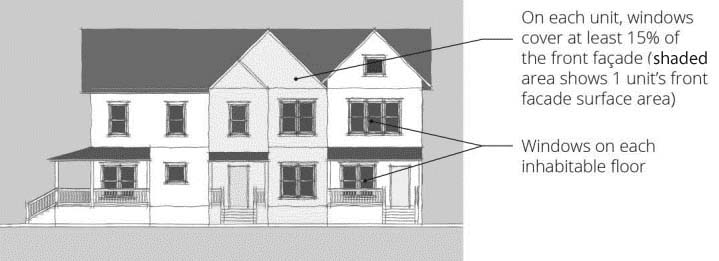
c. Public-Private Transition. The boundary between the public right-of-way and private space shall be defined and bridged through the following:
i. Setbacks. Setbacks from property lines shall be as set forth in Table 1 of SMC 17.15.040. Residences should be set back from the street right-of-way 10 to 15 feet (preferably 10 feet). Porches and stoops may protrude into the front setback (while allowing at least 90 square feet of front yard space). Second story balconies may protrude into the front setback up to five feet.
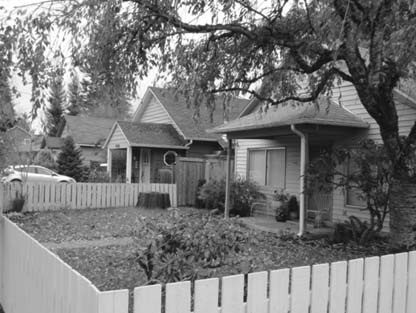
Traditional Snoqualmie homes have well-defined semi-private front yards, in this case, with a low fence.
ii. Alley Setback. A 10-foot setback from the alley right-of-way shall be provided for primary uses and structures. Accessory structures, such as garbage enclosures, may be set back five feet from the alley right-of-way.
iii. Threshold for Semi-Private Space. A physical “threshold” feature such as a low hedge, retaining wall, rockery, gate, low fence, railing, or a combination of such elements shall be provided on private property to distinguish the public sidewalk from the private yard or patio. Thresholds may screen but not block views to and from the street and should help define individual units. Retaining walls should not be taller than four feet; multiple terraces may be used to accommodate greater grade changes.

Thresholds and porches define the transition between public and private spaces.
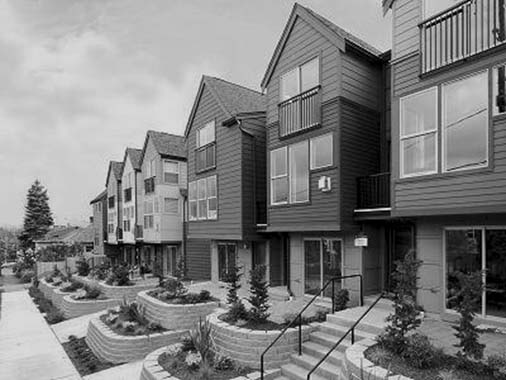
Retaining walls define semi-public zone; patios and covered entrances define semi-private zone.
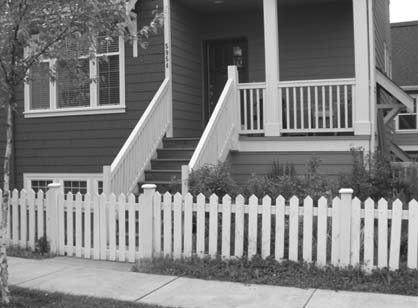
Elevated entries allow for sociability while protecting privacy. This example shows close to the maximum allowed elevated height.
iv. Front Porches, Stoops and Ground Floor Elevations. To ease the transition between the homes and the public area and increase opportunities for social exchange, all ground floor units facing a street or common open space shall provide a front porch or stoop elevated between two and five feet above the sidewalk grade. This guideline does not apply to designated ADA accessible units. In addition, the ground floor windows should be located so that pedestrians on the sidewalk cannot see directly into the lower half of the interior space, either by elevating the base of the window to at least six feet above grade or by providing screening. The ground floor interior space facing the street should be habitable, unless infeasible due to elevation of the first floor living space to meet flood hazard regulations and/or to locate garages under units.
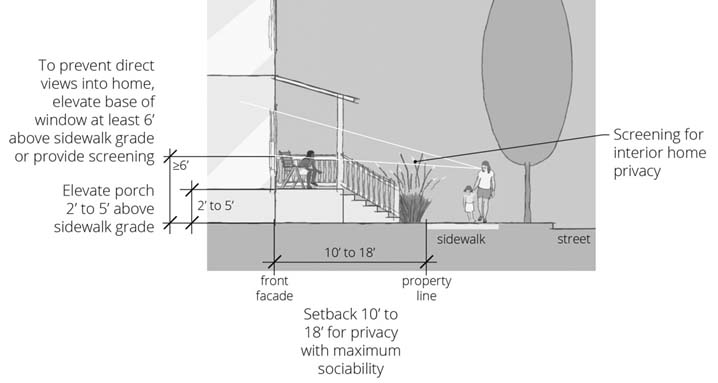
Porch and window elevation and setbacks for privacy with street activation.
v. Covered Entries. To protect people entering the building from weather, entries facing the public realm shall be covered over an area at least four feet by four feet. To accommodate two seats and the entry, porches and stoops shall be a minimum of six feet by six feet.
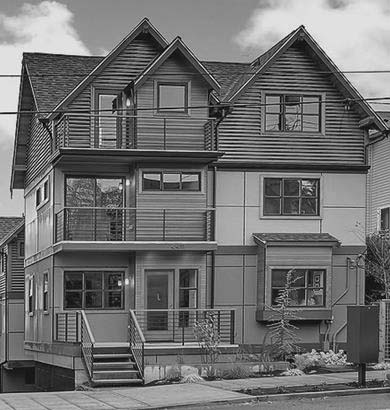
Elevated front porch defines semi-private zone and encourages interaction between residents and street.
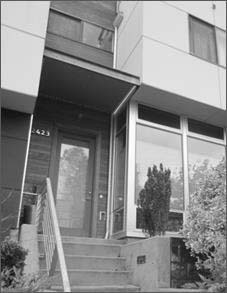
Minimum covered entry acceptable.
d. Privacy on Side Facades. To maintain privacy between neighboring residential properties, windows should not directly face windows of adjacent homes (i.e., they should be staggered).
2. Street Level Entries with Flood Zone Requirements.
a. The first floor of living space must be elevated at least three feet above the 100-year flood elevation, as defined on the current applicable flood insurance rate map, or as required by Chapter 15.12 SMC, whichever is greater.
b. If a garage constitutes the ground floor due to site constraints and/or elevation of the building, to reduce the need for tall front stairs and/or ramps and to maintain a close relationship with the street, each dwelling unit’s porch or stoop shall be elevated between two and five feet above the sidewalk grade, with a corresponding interior split level entry foyer providing stairway access to the ground floor garage level and the elevated first floor level. This standard does not apply to designated ADA accessible units.
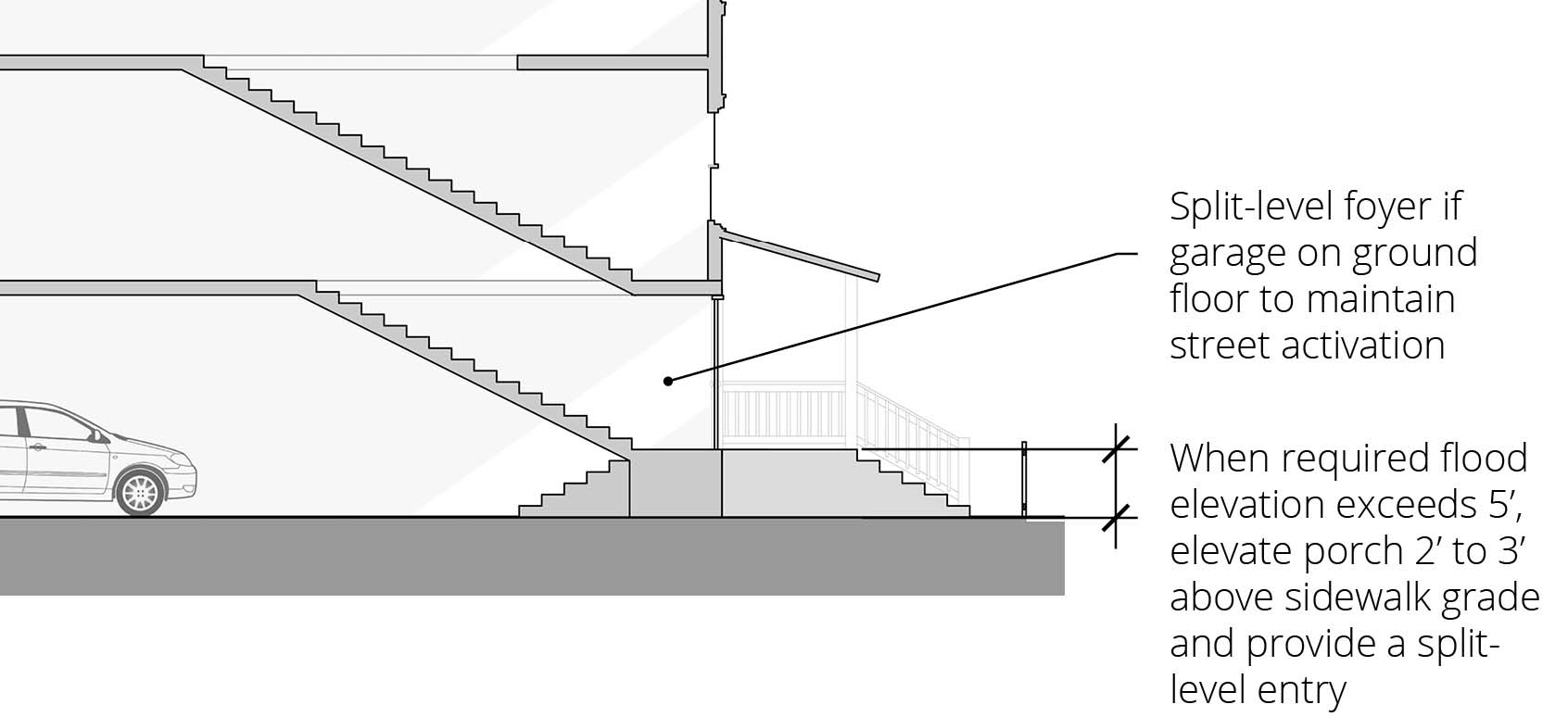
Split-level foyer for flood requirements.
3. Alley Access and Parking. All vehicle access and parking shall come from the adjacent alley. Vehicle access from streets is prohibited. Subdivision of a lot that separates any new lot from existing alley access is prohibited.
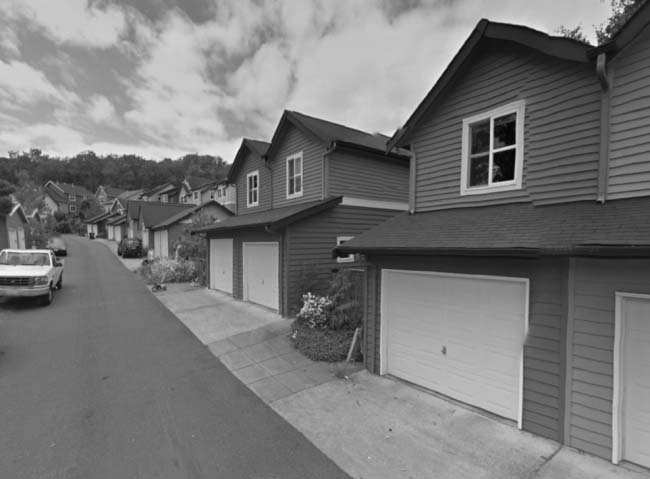
Example of alley-facing garages with accessory dwelling units above.
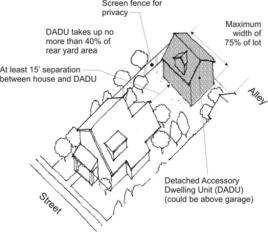
Typical detached accessory dwelling unit (ADU) standards.
4. Blank Walls.
a. Corner Lots. To avoid blank walls and inactive spaces, lots that front two streets or one street and a common open space shall provide pedestrian-friendly architectural treatments, such as wrap-around porches, quality trim and materials (see the building design materials and windows subsections below), and windows and/or balconies facing both sides of the public realm. No ground floor wall shall have a length of 15 feet or greater (measured parallel to the street) without a window, door, porch, special landscaping (e.g., vertical trellis, trees, and shrubs), or other architectural building element that provides visual interest at the pedestrian scale. Townhouse developments, duplexes, triplexes, and quadriplexes on corner lots shall place at least one main entry on each street, unless there is a compelling reason for a shared entry that eliminates the need for multiple entries.
b. Ground Floor Garage Walls at Front Facade. To avoid blank walls and inactive spaces on the front facade due to ground floor garages, the ground floor front facade shall contain a window and be screened with shrubs, trees, trellises, or other landscaping or architectural design elements. LID BMPs may also be proposed for this effect, so long as the proposed landscaping design provides the required screening.
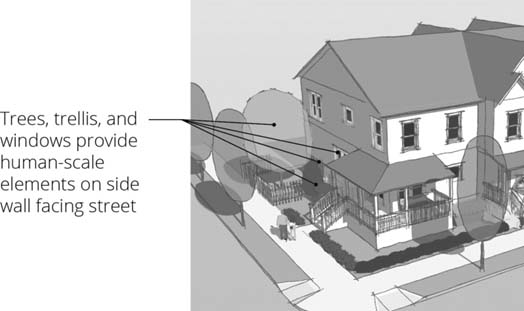
Side wall treatment.
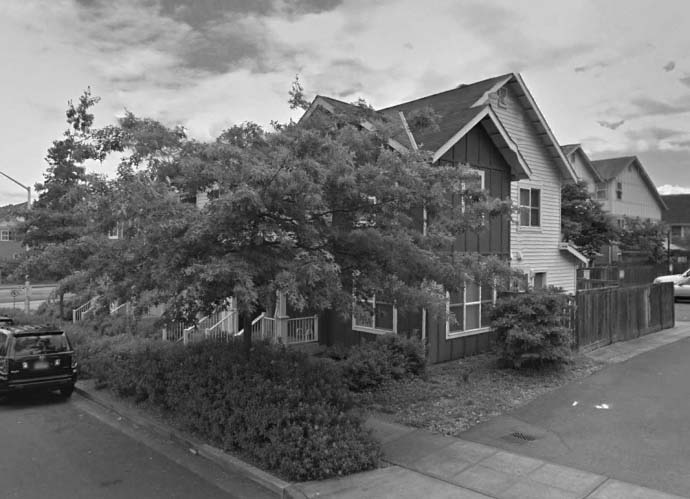
Example of corner lot with quality windows and materials facing both streets with appropriate rear yard privacy screening.
C. Building Design. The following standards encourage building design that reflects Snoqualmie’s historic residential architectural character.
1. Massing Modulation. Building design shall distinguish individual units, except where it is desirable for the building to appear as one home (potentially the case for duplexes, triplexes, and quadriplexes). The maximum length of any continuous front line shall be 30 feet. Front facades longer than 30 feet (measured parallel to the street right-of-way) shall be articulated in one or more of the following ways:
a. Vertical modulation of the front facade by stepping out or back at least five feet;
b. Change of materials;
c. Recessed or projected balconies or porches; and
d. A break in the roof line such as a gable.
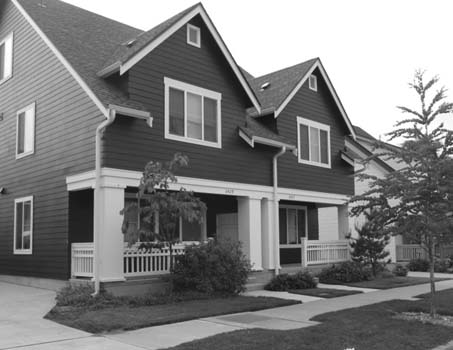
Individual units emphasized through gables and porches.
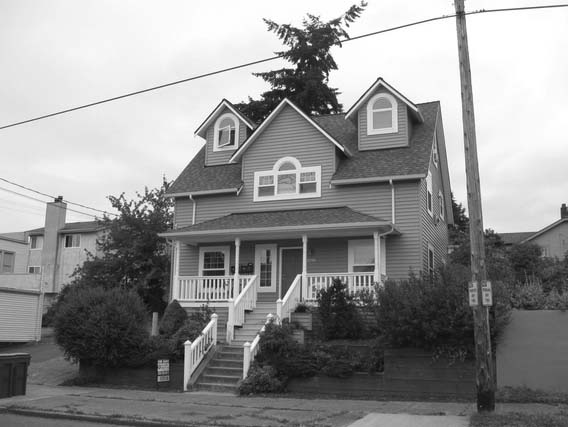
Quadriplex designed to fit in a primarily single family neighborhood, so individual units are not distinguished.
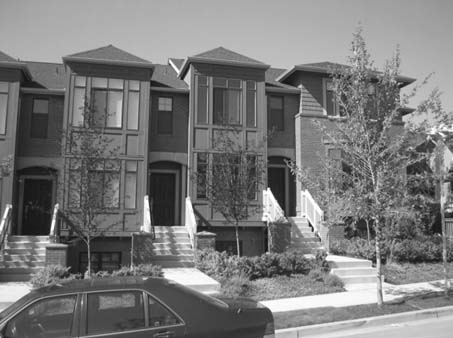
Vertical modulation distinguishes individual units and breaks up a long street-facing facade.
2. Roof Pitch. To reinforce local architectural patterns, primary roof pitches shall range from 6:12 to 12:12. Secondary rooflines, such as porches or projections, may be different than the primary pitches. Roof overhangs shall be a minimum of 12 inches and preferably 18 inches, excluding the gutter. Knee braces should be used when appropriate for the style.
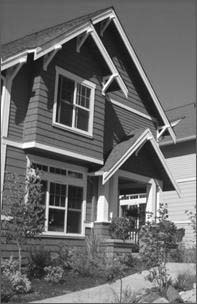
Appropriate roof pitches, overhangs, and modulation through upper bay projection.
3. Window Design. Design for all windows facing streets and common areas shall comply with the following requirements, provided the director may accept an alternative proposal that meets the intent of these standards:
a. To reinforce the scale and pattern of local residential architecture, the majority of individual windows shall be vertical in orientation, no less than a ratio of 1.0 horizontal to 1.6 vertical. Windows may be grouped to provide a horizontal proportion. Transom and accent windows are exempt from this requirement.
b. Arched windows are discouraged.
c. If used, mullion widths shall be a minimum of three-fourths inch. Snap-on mullion simulators are prohibited; only “true divided” panes or “grid between glass” simulators are permitted.
d. Trim around windows shall be at least three and one-half inches wide.
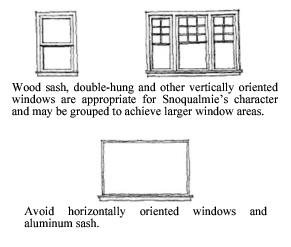
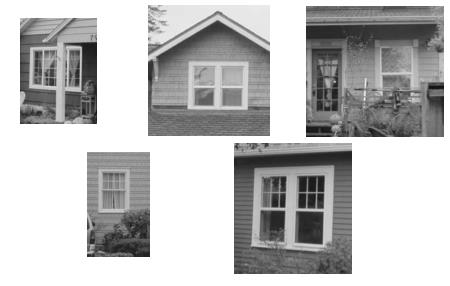
Examples of vertically oriented windows in Snoqualmie with adequately wide mullions and trim.
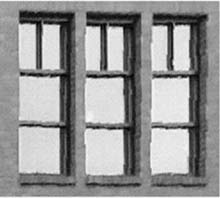
Acceptable recessed windows.
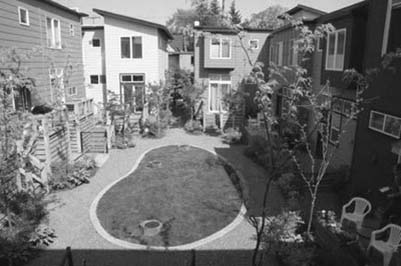
Appropriate windows with contemporary townhouse design. This also shows an appropriate interior court with common open space.
4. Materials and Colors. Building design and construction shall comply with the following:
a. Building exteriors shall be constructed of high quality, durable materials. Preferred materials include wood, brick, and locally sourced natural stone.
b. If using exterior insulation finishing systems (EIFS) or other synthetic stucco finishes, it must be rimmed in durable materials and shall not extend below two feet above grade.
c. Plywood, T111, and similar processed sheet products are prohibited.
d. Adjacent buildings should not have identical color schemes.
e. Multiple colors should be used on building facades, and color transitions should:
i. Reflect material changes and the individuality of each residence; and
ii. Occur at horizontal lines or vertical “inside” edges (e.g., where a bay window meets the rest of the house).
f. Trim should be a lighter color than the body of the home.
g. The gutter color should closely match the trim color. Downspouts and corner boards (if used) should match the color of the adjacent wall surface.
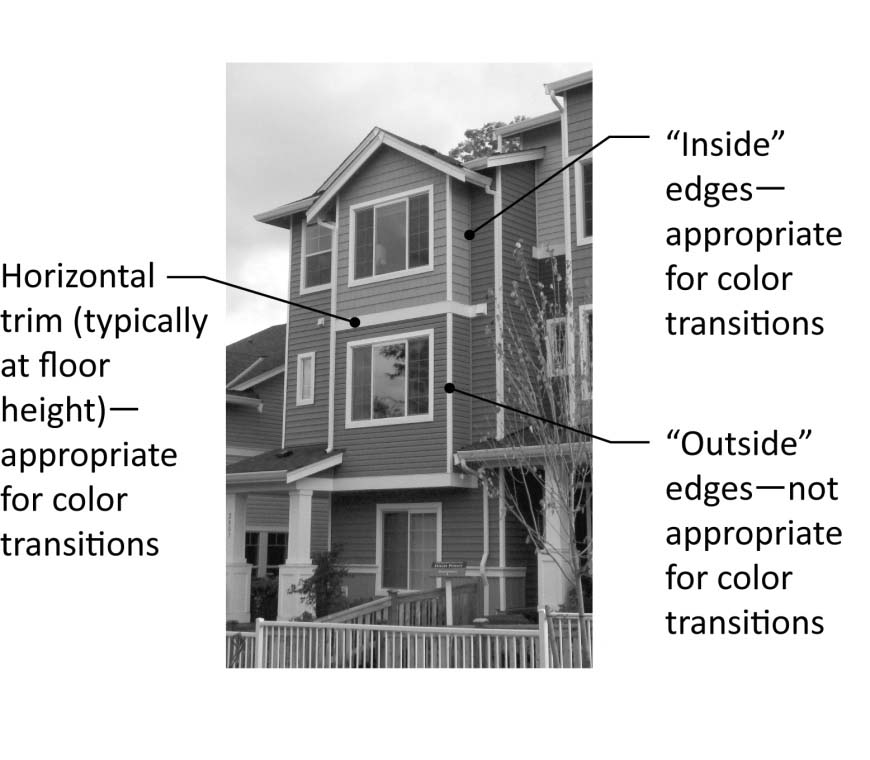
Appropriate color transitions.
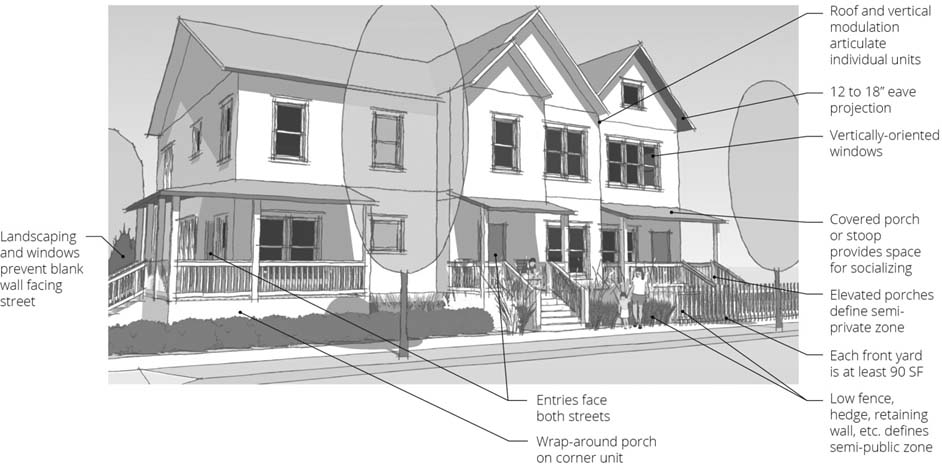
Example of three-unit townhouses on a corner lot that meet standards.
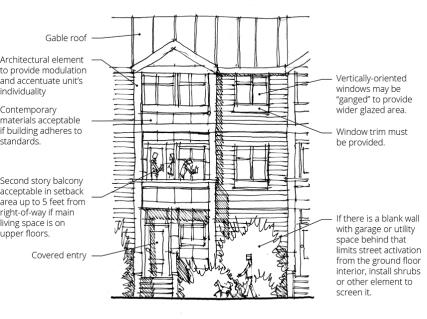
Example of townhouses with ground floor garage and contemporary materials that meet standards.
5. Roof Vents and Mechanical Equipment. To the degree practical, vent stacks, metal chimneys and pipes shall be clustered to avoid rooftop clutter, and where practical located on the roof slope facing away from public streets.
D. Open Space.
1. Private Open Space. A minimum of 200 square feet of private open space shall be provided for each unit (not applicable to approved accessory dwelling units). Private open space may include back yards, front yards, balconies, and porches, or any combination thereof, provided at least 100 square feet of outdoor storage space is provided behind the unit or within garages to avoid front porches or balconies being used for storage. Back yards may have no dimension less than 10 feet and balconies or porches counting toward private open space may have no dimension less than eight feet.
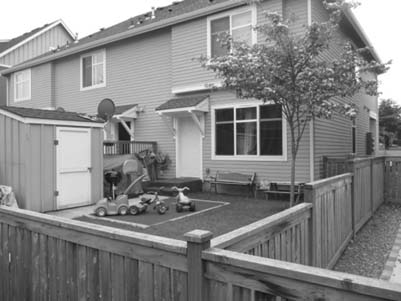
Appropriate back yard.
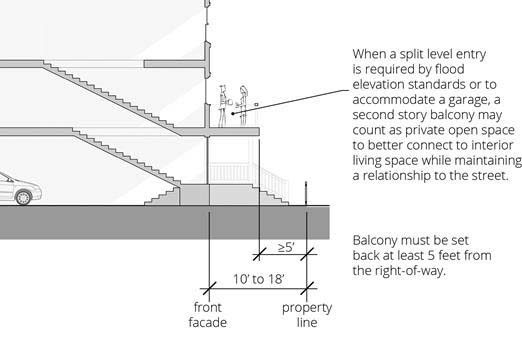
Balconies, porches, and front yards may count toward private open space.
2. Common Open Space. Common open space may be provided instead of private open space, provided, front yards, balconies, porches, stoops and outdoor storage space shall not count toward the 200-square-foot per unit minimum. The minimum dimension of any common open space shall be 15 feet by 20 feet.
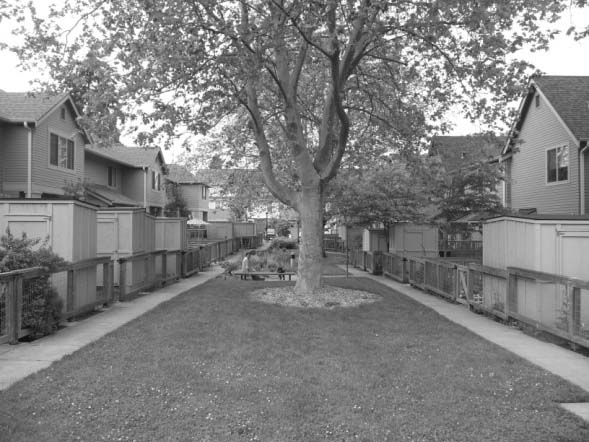
Appropriate shared common space adjacent to private rear yards.
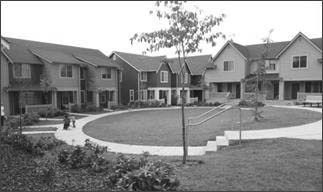
Appropriate shared common space facing front entries.
E. Landscaping.
1. A planted area of at least 20 square feet in area shall be provided between individual, noncontiguous garages, with no dimension less than four feet, and shall include a street tree and a combination of shrubs or groundcover (refer to city arborist or street tree list if available for appropriate species).
2. Except for driveway areas, the alley setback shall be planted as a Type III landscape area, pursuant to the requirements of Chapter 17.70 SMC.
3. Perimeter Buffers. Perimeter landscape buffers shall be provided pursuant to Chapter 17.70 SMC to provide separation between incompatible adjacent land uses or activities. Perimeter landscape buffers shall not be required between multifamily developments; however, landscape plantings shall be provided to accommodate a change in design within a site or between adjacent sites. Preservation of native vegetation or existing healthy nonnative trees and shrubs within perimeter buffer areas shall be encouraged.
4. Foundation Plantings. To create an effective change from public to private space, and to “anchor” the building to the ground, foundation plantings shall be provided around all individual buildings.
5. Fences. Fences located between buildings and public streets shall be no taller than three feet. Other fences, including those used to screen parking areas, shall be a maximum of six feet in height. Fences shall be made of wood, wrought iron, or masonry, and compatible with the architectural style of the building(s).
F. Internal Pedestrian Paths and Circulation.
1. Pedestrian access shall be provided in accordance with the Americans with Disabilities Act.
2. A pedestrian walkway shall be provided from the street to each front entry.
3. Internal walkways shall be provided as needed to connect parking spaces and internal open space features to building entries.
4. Pedestrian paths shall be at least four feet wide and should be separated from vehicular areas by landscape areas.
5. Overall on-site pedestrian circulation routes shall be shown on site plans. Pedestrian pathways shall be integrated with the required on-site landscaping, including landscaping within common areas.
G. Service, Loading and Garbage Areas. Trash and recycling receptacles shall be provided as required by SMC 15.10.020. Trash/recycling receptacles and satellite dishes or other communications equipment shall be located on the lot in such a manner that they are visually obscured from adjacent residential uses, streets, public walkways or trails, and public parks or open space areas. Trash and recycling containers shall be enclosed on all sides with solid walls or fences and gates. Enclosures shall be designed to be compatible with the architectural style and materials of the project as a whole. (Ord. 1198 § 22 (Exh. D), 2017; Ord. 1151 § 4, 2015).
17.15.060 Recreation space requirements.
In all zoning districts, any proposed multiple-family structure, complex, or development of four or more units shall provide on the premises and for the use of the occupants a minimum amount of recreation space according to the following provisions:
A. Required Area.
1. For each proposed dwelling unit in the multiple-family complex or development, a minimum of 200 square feet of recreation space shall be provided. Any multiple-family structure, complex, or development shall provide a minimum of 1,000 square feet of total recreation space.
2. The front, side, and rear yard setback areas required by the applicable zoning district shall not qualify as recreation space, except that 10 percent of the required landscape areas may be permitted in the calculation of the total recreation space.
3. In the event the total area required under subsection A of this section is less than 3,000 square feet, that portion required to be outdoors and uncovered shall be one continuous parcel of land.
B. Indoor or Covered Space.
1. No more than 50 percent of the required recreation space may be indoor or covered space.
2. No more than 50 percent of the total required recreation space may be used for single-purpose permanent facilities such as swimming pools, tennis courts, and similar facilities.
C. Uncovered Space.
1. A minimum of 50 percent of the total required recreation space shall be open or uncovered; up to 100 percent of the total requirement may be in open or uncovered recreation space.
2. No more than 50 percent of the uncovered recreation space requirement may be located on slopes greater than four horizontal to one vertical (4:1) slope.
D. General Requirements.
1. Multiple-family complexes which provide dwelling units with two or more bedrooms shall provide adequate recreation space for children. Such space shall be at least 25 percent but not more than 50 percent of the total recreation space required under subsection A of this section and shall be designated, located, and maintained in a safe condition.
2. Adequate fencing, plant screening, or other buffer shall separate the recreation space from parking areas, driveways, or public streets. (Ord. 1198 § 22 (Exh. D), 2017; Ord. 744 § 2, 1995).
17.15.070 Special provisions applicable to certain legal nonconforming lots within residential constrained district (R-C).
Notwithstanding any other provision of this title, allowable uses on lots within the residential constrained district having a lot area of less than five acres shall be as established in SMC 17.55.020 for the R-1 residential district. (Ord. 1198 § 22 (Exh. D), 2017; Ord. 942 § 2, 2003; Ord. 898 § 2, 2002).
Code reviser’s note: Ord. 1151 adds these provisions as Section 17.15.060. The section has been editorially renumbered to prevent duplication.


